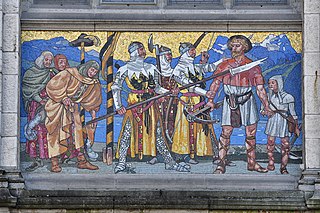 W
WThe German Peasants' War, Great Peasants' War or Great Peasants' Revolt was a widespread popular revolt in some German-speaking areas in Central Europe from 1524 to 1525. It failed because of intense opposition from the aristocracy, who slaughtered up to 100,000 of the 300,000 poorly armed peasants and farmers. The survivors were fined and achieved few, if any, of their goals. Like the preceding Bundschuh movement and the Hussite Wars, the war consisted of a series of both economic and religious revolts in which peasants and farmers, often supported by Anabaptist clergy, took the lead. The German Peasants' War was Europe's largest and most widespread popular uprising prior to the French Revolution of 1789. The fighting was at its height in the middle of 1525.
 W
WThe Baltringer Haufen was prominent among several armed groups of peasants and craftsmen during the German Peasants' War of 1524–1525. The name derived from the small Upper Swabian village of Baltringen, which lies approximately 25 kilometres (16 mi) south of Ulm in the district of Biberach, Germany. In the early modern period the term Haufe(n) denoted a lightly organised military formation particularly with regard to Landsknecht regiments.
 W
WThe Black Company or the Black Troops was a unit of Franconia farmers and knights that fought on the side of the peasants during the Peasants' Revolt in the 1520s, during the Protestant Reformation in Germany.
 W
WHans Müller, also known as Hans Müller von Bulgenbach,, was a peasant leader during the German Peasants' War. After a career in the French military, he played a pivotal role in the initial peasant uprising at Stuhlingen, and organized peasant bands throughout southwestern Germany. He was captured after the peasants' loss at Klettgau in July 1525, imprisoned at the Hohentweil fortress, and executed in August of that year.
 W
WThe Bundschuh movement refers to a series of localized peasant rebellions in southwestern Germany from 1493 to 1517. They were one of the causes of the German Peasants' War (1524–1526). The Bundschuh movement was not a movement in the proper sense, but a number of loosely linked local conspiracies and planned uprisings. It was so called because of the peasant shoe (Bundschuh) the peasants displayed on their flag. Under this flag, peasants and city dwellers had defeated the troops of the French count of Armagnac along the upper Rhine in 1439, 1443, and 1444.
 W
WEarly Bourgeois Revolution in Germany, also known as the Peasants' War Panorama (Bauernkriegspanorama), is a monumental painting by the East German painter Werner Tübke, executed from 1976 to 1987. It spans 14 metres (46 ft) by 123 metres (404 ft) and depicts a circular panorama of the Battle of Frankenhausen, fought on 15 May 1525 during the German Peasants' War. The painting has more than 3000 characters.
 W
WThe Battle of Frankenhausen was fought on 14 and 15 May 1525. It was an important battle in the German Peasants' War and the final act of the war in Thuringia: joint troops of Landgrave Philip I of Hesse and Duke George of Saxony defeated the peasants under their spiritual leader Thomas Müntzer near Frankenhausen in the County of Schwarzburg.
 W
WGeorg III Truchsess von Waldburg-Zeil, also known as Bauernjörg, was a Swabian League Army Commander in the German Peasants' War.
 W
WFlorian Geyer von Giebelstadt was a German nobleman, diplomat, and knight. He became widely known for leading peasants during the German Peasants' War.
 W
WHans Hut was a very active Anabaptist in southern Germany and Austria.
 W
WThe Knights' Revolt was a revolt by a number of Protestant and religious humanist German knights led by Franz von Sickingen, against the Roman Catholic Church and the Holy Roman Emperor. It has also been called the "Poor Barons' Rebellion." The revolt was short-lived but would inspire the bloody German Peasants' War of 1524–1526.
 W
WThomas Müntzer was a German preacher and radical theologian of the early Reformation whose opposition to both Martin Luther and the Roman Catholic Church led to his open defiance of late-feudal authority in central Germany. Müntzer was foremost amongst those reformers who took issue with Luther's compromises with feudal authority. He became a leader of the German peasant and plebeian uprising of 1525 commonly known as the German Peasants' War. He was captured after the Battle of Frankenhausen, tortured and executed.
 W
WThe Palatine Peasants' War was part of the general German Peasants' War on the Middle and Upper Rhine. The uprising in the Palatine Electorate and its surrounding area took place in April to June 1525.
 W
WThe Poor Conrad was the name of several secret peasants' leagues, which in 1514 revolted against the rule of Duke Ulrich of Württemberg. The rebels adopted the term used by the nobility to mock them, meaning "poor fellow" or "poor devil". The battle flag of the rebels depicted a farmer lying in front of a cross, under the words Der arme Conrad.
 W
WThe Twelve Articles were part of the peasants' demands of the Swabian League during the German Peasants' War of 1525. They are considered the first draft of human rights and civil liberties in continental Europe after the Roman Empire. The gatherings in the process of drafting them are considered to be the first constituent assembly on German soil.
 W
WWilliam Tell is a folk hero of Switzerland. According to the legend, Tell was an expert marksman with the crossbow who assassinated Albrecht Gessler, a tyrannical reeve of the Austrian dukes of the House of Habsburg positioned in Altdorf, in the canton of Uri. Tell's defiance and tyrannicide encouraged the population to open rebellion and a pact against the foreign rulers with neighbouring Schwyz and Unterwalden, marking the foundation of the Swiss Confederacy.
 W
WWeigand of Redwitz was Prince-Bishop of Bamberg from 1522 until his death.
 W
WThe Battle of Wurzach, was a battle during the German Peasants' War that took place near Bad Wurzach in the present-day county of Ravensburg in Upper Swabia.